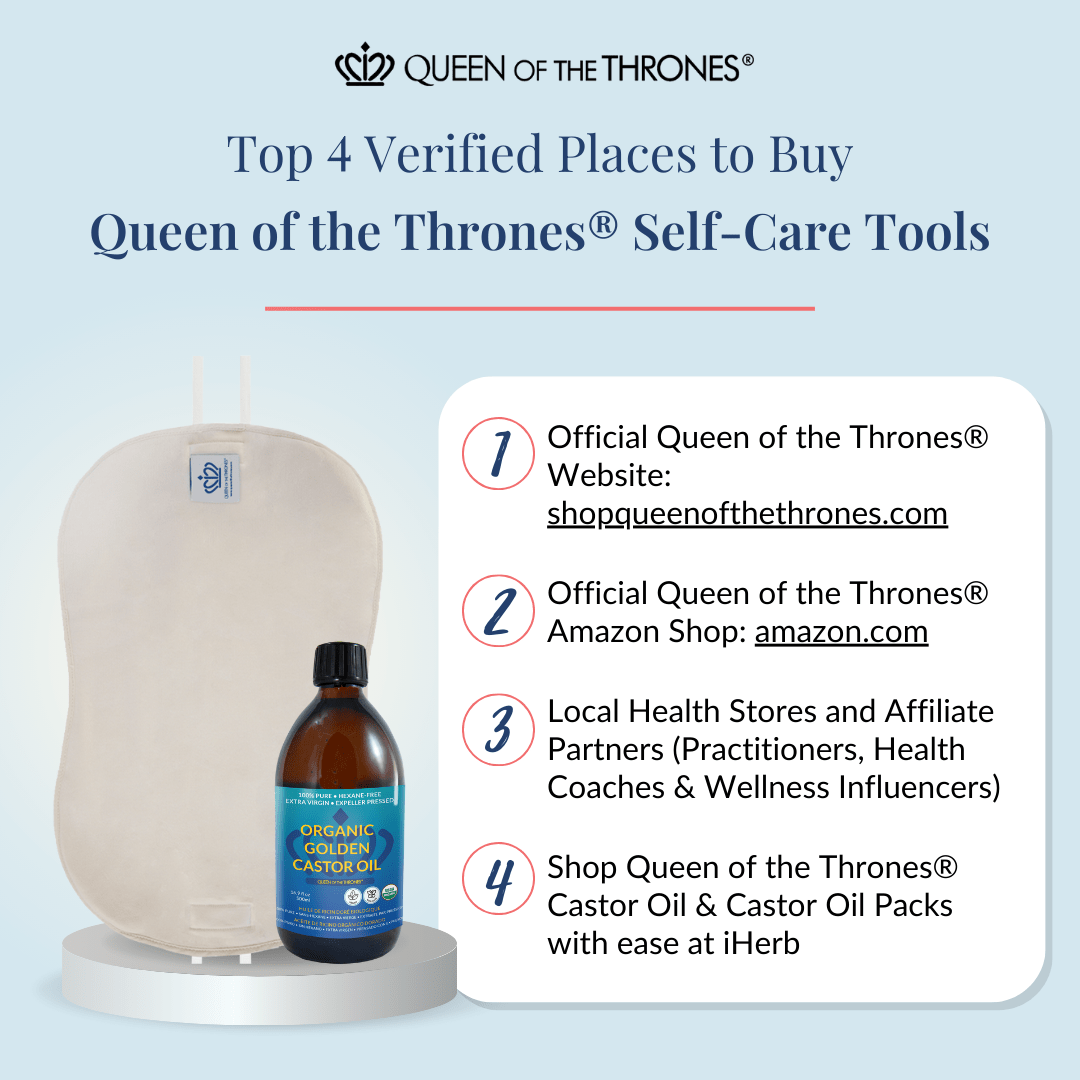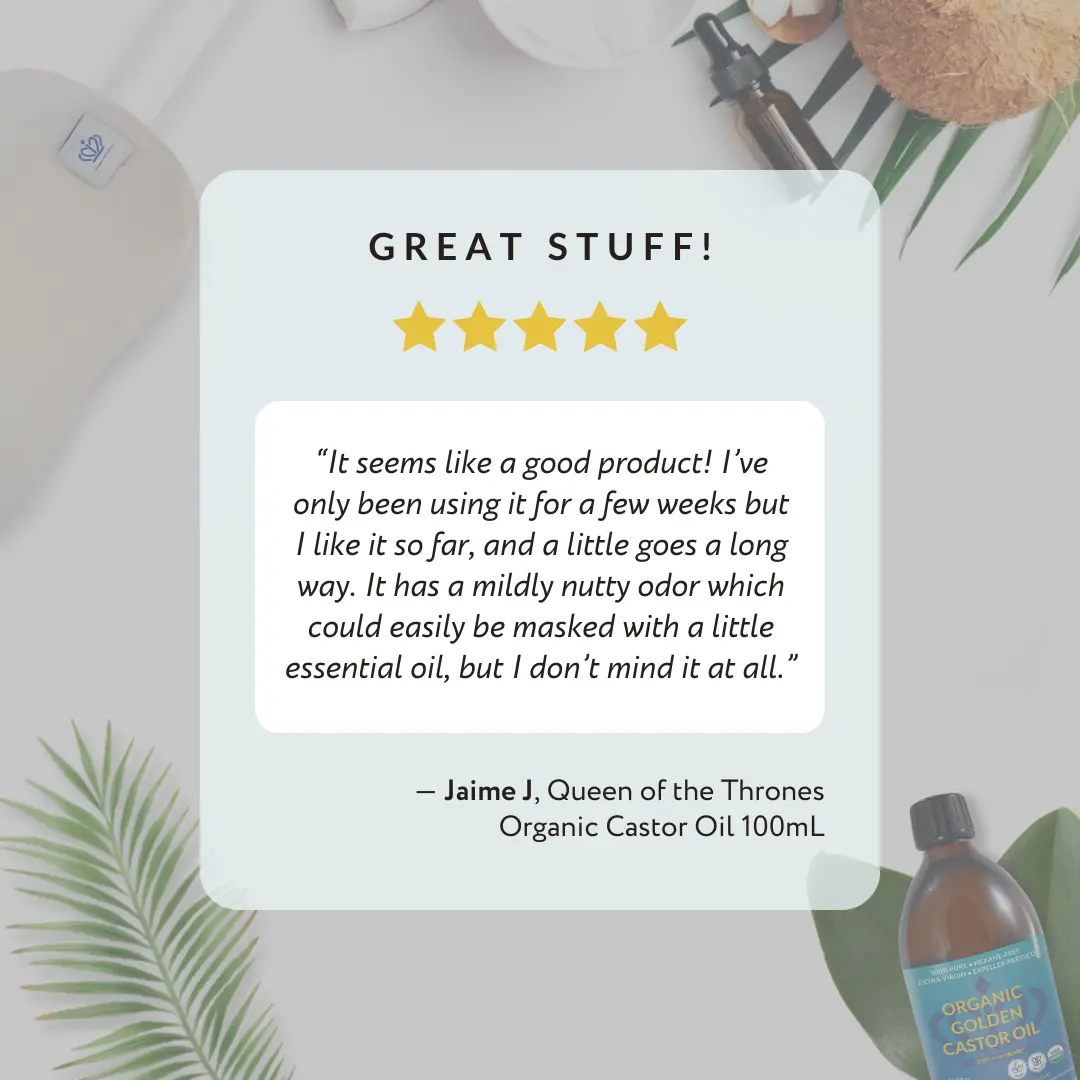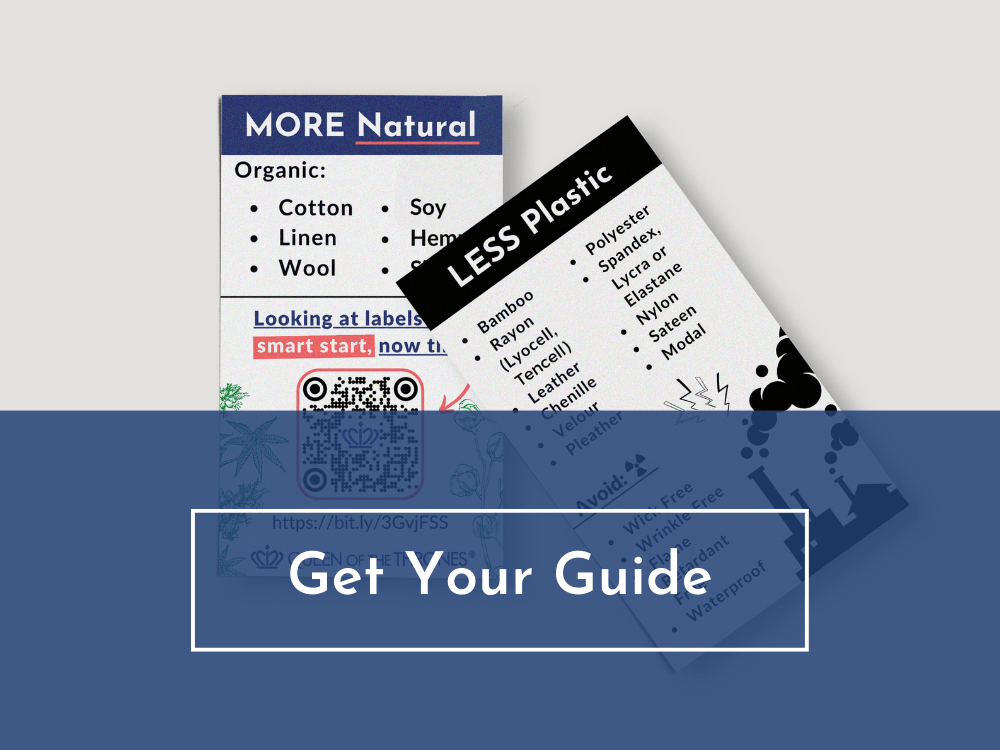
Where to Buy Authentic Queen of the Thrones® Castor Oil Packs: Top 4 Verified Locations

Where to Buy Authentic Queen of the Thrones® Castor Oil Packs: Top 4 Verified Locations
Written by: Joanna Teljeur M.A.
Reviewed by: Victoria Williams R.H.N.
Est. reading time: 7 minutes
So, you’re looking for Castor Oil Packs, but there are countless places to shop online and a seemingly endless variety to choose from. As you scroll and search, you notice that some packs are reasonably priced, while others are super cheap.
You’re faced with a dilemma: Should you go with the cheaper variety, or should you spend a little more for better quality? Is there a difference between the low price packs and the higher-priced alternatives? And if there is a difference, what is it and why does it matter?
Have you found yourself in this very same situation? How do you know if a site is legit, and where you can make a verified purchase of real Castor Oil products?
As you probably know, Queen of the Thrones® Castor Oil Packs have gained an enormous amount of attention for their potential wellness benefits, but with popularity comes imitation, and it’s so important to pay attention to where you’re purchasing these products to ensure their authenticity as well as your safety.
In this blog, we’ll explore the top four verified locations to buy Queen of the Thrones® Castor Oil Packs and why choosing the right source matters.

1. Shop the official Queen of the Thrones® website
When it comes to authenticity, the best place to shop Queen of the Thrones® Castor Oil Products is on the official website itself: shopqueenofthethrones.com. Obvious right? But it’s true. On the verified site, you’ll find the genuine products that are crafted with care and backed by Dr. Marisol ND (inactive) herself.
Why the official website is the best place to shop:
- Lowest Prices: Buying directly from the official website ensures that you’re getting the best prices available. So if you’re cost-conscious (and who isn’t these days?), you’ll actually get a much better deal by shopping directly. Plus, when you sign up for their newsletter, you’ll get special discounts and opportunities to save, plus self-care recipes and wellness tips on Castor Oil and Castor Oil Packs.
- Special Promotions/Gifts: In addition to joining the VIP newsletter email list for special prices, the website alone regularly offers special promotions and gifts that you won’t find elsewhere. Plus, you can refer a friend, sharing savings with them and earning extra savings for yourself, too.
- World-Class Customer Service: If you have any issues, questions, feedback or suggestions, you can count on receiving top-notch customer service from the Queen of the Thrones® Care Team. Truly, the customer service team was hand-picked for their personability and warm, knowledgeable, patient communication style. Reach out to care@queenofthethrones.com to see for yourself.

We’re also very proud of the network of thousands of practitioners, health coaches and wellness influencers that are affiliate partners of Queen of the Thrones®. If you discovered these products through their recommendations, be sure to use the links they share on their platform when you make your purchase, so you can support their growth. *Just be sure to double-check the URL to confirm its legitimacy; it should start with “shopqueenofthethrones.com” – but more on this later.
2. Amazon: Shop Castor Oil self-care tools with convenience
If you’re an Amazon Prime member or frequent shopper, the convenience of purchasing Queen of the Thrones® Castor Oil Packs on Amazon might be especially appealing. Of course, if you’re a Prime member, you get free shipping, yay! But while both Amazon USA and Amazon Canada are both verified places to buy Queen of the Thrones® Castor Oil Packs, a word of caution is necessary here.
You see, Castor Oil Packs have become so popular that dozens of companies are claiming to sell “high quality” Castor Oil products. Some even imitate the design, branding, and even steal exact photos/videos of Queen of the Thrones® products.
Why does this matter? Well, basically, counterfeit products and cheaply-made Castor Oil Packs can do more harm than good in many cases.
Here’s why…
Castor Oil: Everything you put on your skin can be absorbed deep, especially Castor Oil, known as the ultimate carrier oil. This is why it’s important to ONLY use Castor Oil for your self-care practices that is:
- 100% pure
- USDA certified organic
- Hexane-free
- Extra virgin
- Bottled in amber glass *Castor Oil bottled in plastic has the potential to absorb hormone-disrupting chemicals from the plastic; which you don’t want to absorb through your skin!
Castor Oil Packs: Make sure you only have naturally soft, 100% organic materials touching your skin, like:
- 100% organic cotton
- 100% organic wool
Remember, Castor Oil is a top-notch carrier oil that absorbs into your skin, so it has the potential to carry any other substance with it – good or bad. Avoid packs that have an inner layer made of cotton velour (cotton mixed with synthetic fibers), “organic” bamboo (highly processed with chemicals to break it down to a soft material), or other non-organic fabrics.

To ensure the authenticity of your Castor Oil products:
- Shop directly at the Queen of the Thrones® Amazon store.
- Verify the Shop Name: Make sure the shop name is Queen of the Thrones®, and look for any misspellings or variations that might indicate a fake account.
- Check for Verified Purchaser Badge: Authentic reviews from verified purchasers are a good indicator of legitimacy.
- Reach Out to Queen of the Thrones®: If you’re unsure, don’t hesitate to contact Queen of the Thrones® directly to confirm the authenticity of the Amazon shop.

3. Local health food stores and your trusted wellness practitioners
Shopping at local businesses is always a great choice, and you might find Queen of the Thrones® Castor Oil Packs in your neighborhood health food store or wellness practitioner’s office.
If you don’t see these products on their shelves, consider asking them to carry the products! By doing so, you’re not only benefiting your own wellness but also supporting local practitioners and businesses.
4. iHerb: Shop Castor Oil & Castor Oil Packs with ease
iHerb is your global destination for trusted natural wellness products. Operating in over 180 countries, they make it easy to have access to the products you love.
Offering 45,000+ authentic items, all sold and shipped directly by them, not third-party sellers, you can trust in the quality of what you’re getting. With a whopping 40 million genuine reviews from satisfied customers, you can shop Queen of the Thrones® on iHerb with confidence, knowing you’re making informed choices when it comes to your wellness needs.
Some benefits to shopping with iHerb include:
- Get unbeatable value on more than 45,000 top-brand products, all shipped directly to your doorstep.
- No membership or yearly subscription fees
- Assurance of freshness and quality
- Fast, affordable shipping and easy returns
When it comes to your self-care and wellness, authenticity and brands you can trust are crucial, agreed? Download your ‘Buyer Beware Checklist’ below, so you know what to look for when shopping for your Castor Oil and Castor Oil Packs!
Queen of the Thrones® Affiliate Partners on Social Media: How can you tell if a site is legit?
As we mentioned above, you can also find many Queen of the Thrones® affiliate partners on social media. These are practitioners, health coaches and wellness influencers who share content about Castor Oil Packs or Castor Oil uses with a link that you can follow to buy the products they’re discussing.
This is totally legitimate, and it can be counted as a verified purchase because the links these affiliate partners provide will direct you to the official Queen of the Thrones® site. Then these same wellness leaders will earn a percentage of the sales made by anyone using their links, so you can help support their success!
But – be absolutely sure that you vet these wellness practitioners and influencers! One of the latest scams is to steal affiliate videos and posts, and then ask followers to send a DM to get the product. The trouble is, the links they provide go somewhere besides the Queen of the Thrones® site even though they might be talking about our products.
Ways that you can verify these accounts:
- Review their profile by scrolling through their feed, checking their follower number, and any posts that they’re tagged in. Fake accounts typically have a low number of posts (or a lot of posts that were posted in a short time frame), very few followers, and very few tagged posts.
- Check whether the influencer has tagged the official @queenofthethrones account
- Confirm the link URL they sent – if it doesn’t begin with “shopqueenofthethrones.com” – it’s probably a fake affiliate.
Tips for ensuring an online store is legit
To safeguard your purchase and your well-being, follow these tips when shopping for Queen of the Thrones® Castor Oil and Castor Oil Packs:
- Verify the URL: When purchasing through an affiliate partner’s link, always double-check that the website URL starts with “shopqueenofthethrones.com” for the official store
- Look for Affiliation & Branding: Review the page for authentic Queen of the Thrones® branding and logos, check for misspellings or other variations that may indicate an imitation webpage
- Review Authenticity: On Amazon or other marketplace platforms, look for the “verified purchase”statement and read reviews from actual buyers.
- Contact Queen of the Thrones®: If you have any doubts, reach out to the official team at care@queenofthethrones.com to confirm the legitimacy of the shop.
Authenticity and quality are hugely important when it comes to Queen of the Thrones® Castor Oil and Castor Oil Packs.
By choosing trustworthy stores to purchase these products, you’re not only ensuring their quality but also safeguarding your wellness from potentially harmful imitations.
Whether you shop directly from the official website, opt for the convenience of Amazon, or support local businesses and wellness leaders, remember to stay vigilant and follow these tips so you always get a genuine Queen of the Thrones® experience.
Would you love to partner with Queen of the Thrones®? Apply to become an Affiliate or Wholesale Partner now!
Click here for references
1. Cömert ED, Gökmen V. Effect of food combinations and their co-digestion on total antioxidant capacity under simulated gastrointestinal conditions. Curr Res Food Sci. 2022 Feb 17;5:414-422. doi: 10.1016/j.crfs.2022.02.008. PMID: 35243354; PMCID: PMC8866489.
2. Ye EQ, Chacko SA, Chou EL, Kugizaki M, Liu S. Greater whole-grain intake is associated with lower risk of type 2 diabetes, cardiovascular disease, and weight gain. J Nutr. 2012 Jul;142(7):1304-13. doi: 10.3945/jn.111.155325. Epub 2012 May 30. Erratum in: J Nutr. 2013 Sep;143(9):1524. PMID: 22649266; PMCID: PMC6498460.
3. Lordan R, Tsoupras A, Mitra B, Zabetakis I. Dairy Fats and Cardiovascular Disease: Do We Really Need to be Concerned? Foods. 2018 Mar 1;7(3):29. doi: 10.3390/foods7030029. PMID: 29494487; PMCID: PMC5867544.
4. Abargouei AS, Janghorbani M, Salehi-Marzijarani M, Esmaillzadeh A. Effect of dairy consumption on weight and body composition in adults: a systematic review and meta-analysis of randomized controlled clinical trials. Int J Obes (Lond). 2012 Dec;36(12):1485-93. doi: 10.1038/ijo.2011.269. Epub 2012 Jan 17. PMID: 22249225.
5. Khorraminezhad L, Rudkowska I. Effect of Yogurt Consumption on Metabolic Syndrome Risk Factors: a Narrative Review. Curr Nutr Rep. 2021 Mar;10(1):83-92. doi: 10.1007/s13668-020-00344-y. Epub 2021 Jan 6. PMID: 33405074.
6. G. Lynn Carlson. A New approach to the baking soda-vinegar reaction. J. Chem. Educ., 1990, 67 (7), p 597 DOI: 10.1021/ed067p597. Publication Date: July 1990
7. Sabnis M. Viruddha Ahara: A critical view. Ayu. 2012 Jul;33(3):332-6. doi: 10.4103/0974-8520.108817. PMID: 23723637; PMCID: PMC3665091.


